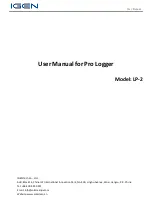
HOBO Pendant Temperature Data Logger (UA-001-xx) Manual
1-800-LOGGERS (564-4377) • 508-759-9500
www.onsetcomp.com • loggerhelp@onsetcomp.com
© 2011–2013 Onset Computer Corporation. All rights reserved. Onset, HOBO, Pendant, and
HOBOware are trademarks or registered trademarks of Onset Computer Corporation. All other
trademarks are the property of their respective companies.
Patent # 6,826,664
9531-J MAN-UA-001
Protecting the Logger
The logger can be damaged if the water depth rating is
exceeded. The depth rating is approximately 30 m (100 ft) at
temperatures below 20°C (68°F), but is less in warmer water.
Refer to Plot C for details.
Do not store the logger in the coupler. Remove the logger from
the coupler when you are not using it. When the logger is in the
coupler or near a magnet, it consumes more power and will
drain the battery prematurely.
Keep the logger away from magnets. Being near a magnet can
cause false coupler events to be logged. It can also launch the
logger prematurely if it was waiting for a trigger start.
Periodically inspect the desiccant and dry it if it is not bright
blue. The desiccant pack is located in the cap of the logger. To
dry the desiccant, remove the desiccant pack from the cap and
leave the pack in a warm, dry location until the bright blue
color is restored. (Refer to the
Battery
section for instructions
on removing and replacing the logger cap.)
Temperature Range
Desiccant Maintenance Schedule
Less than 30°C (86°F)
Approximately once per year
30° to 40°C (86° to 104°F)
Approximately every six months
Over 40°C (104°F)
Approximately every three months
Note! Static electricity may cause the logger to stop logging.
To avoid electrostatic discharge, transport the logger in an anti-
static bag, and ground yourself by touching an unpainted metal
surface before handling the logger. For more information,
search for “static discharge” in the FAQ section on
onsetcomp.com.
Battery
The logger requires one 3-Volt CR-2032 lithium battery. Battery
life varies based on the temperature and the frequency at
which the logger is recording data (the logging interval). A new
battery typically lasts one year with logging intervals greater
than one minute. Deployments in extremely cold or hot
temperatures, or logging intervals faster than one minute, may
significantly reduce battery life.
Continuous logging at the fastest
logging rate of one second will deplete
the battery in as little as two weeks.
To replace the battery:
1. Remove the two screws that
secure the end cap to the case and
remove the cap.
2. Examine the desiccant pack that is
tucked into the cap. If the
desiccant is not bright blue, put
the desiccant pack in a warm, dry
place until the blue color is
restored.
3. Gently tap the case to loosen the
circuit board and remove it from
the case.
4. Carefully push the battery out of
the holder with a small, nonmetallic blunt instrument.
5. Insert a new battery, positive side facing up.
6. Return the circuit board and label to the case, carefully
aligning the circuit board with the grooves in the case so
that the battery faces the ridged side of the case.
7. Replace the end cap, ensuring that the desiccant pack is
tucked into the cap, and the o-ring is seated in the groove,
not pinched or twisted. Make sure no dirt or lint is trapped
on the o-ring, as this could result in a leak.
8. Re-fasten the screws. Do not over-tighten the screws.
WARNING:
Do not cut open, incinerate, heat above
85°C (185°F), or recharge the lithium battery. The battery
may explode if the logger is exposed to extreme heat or
conditions that could damage or destroy the battery case. Do
not dispose of the logger or battery in fire. Do not expose the
contents of the battery to water. Dispose of the battery
according to local regulations for lithium batteries.
Alarms
Configure alarms to flash a warning on the high or low LEDs if
monitored sensor falls outside user-selectable limits.
1.
From the Launch Logger window in HOBOware, click the
Alarms button to open the Configure Alarms window.
2.
Select the check box for the High Alarm and/or the Low
Alarm. Type a value in each box to define the alarm
threshold or use the sliders.
3.
Type the number of out-of-range samples that are needed
to trigger each alarm.
4.
Choose an Alarm Mode. If you select Cumulative, the alarm
will be triggered after a specific number of samples have
been logged above or below an allowed value, even if the
samples are not logged consecutively. If you select
Consecutive, the alarm will be triggered only when the
value has been above or below an allowed value for a
specific amount of time. If the value goes back in range
before triggering the alarm, the count is reset.
5.
Click OK when done.





















